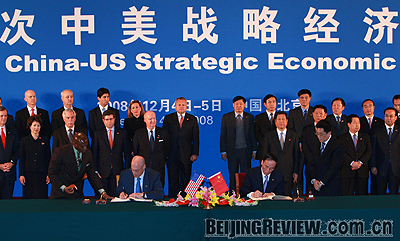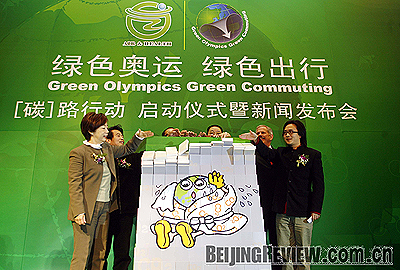|
|

GREEN PARTNERSHIP: Chinese Vice Premier Wang Qishan (front right) and U.S. Treasury Secretary Henry Paulson (front left) sign a framework document to establish eco-partnerships between Chinese and U.S. local governments, universities and companies on December 4 in Beijing |
As Chinese and U.S. officials concluded their last Strategic Economic Dialogue (SED) during George W. Bush's presidency, there were high expectations that the two countries would keep up their efforts to foster sustainable economic relations. The fifth SED was held in Beijing on December 4-5, just over a month before U.S. President-elect Barack Obama's inauguration.
|
 JOINT ACTION: The China Association for NGO Cooperation and the U.S. Environmental Defense Fund launch an initiative to promote a green Olympics on April 3 in Beijing
JOINT ACTION: The China Association for NGO Cooperation and the U.S. Environmental Defense Fund launch an initiative to promote a green Olympics on April 3 in Beijing | During the talks, officials led by Chinese Vice Premier Wang Qishan and U.S. Treasury Secretary Henry Paulson discussed international economic cooperation, financial reform, investment, energy, the environment and food safety and reached 40 agreements.
Chinese President Hu Jintao and Bush conceived the Cabinet-level SED in 2006 to address strategic economic issues. To date, the two countries have convened five SED meetings.
"We look forward to continuing frank, pragmatic dialogue with the new government in the United States to jointly advance our two countries' economic and trade relations," Wang said at a press conference at the end of the fifth SED.
Against the backdrop of the ongoing financial crisis, the fifth SED underlined the need for China and the United States to work together to reinvigorate the global economy. Economic dialogue between China and the United States is bound to continue under the Obama administration, experts said.
Addressing economic woes
The SED was highly relevant in the context of the worsening global financial and economic situations today, said Yuan Peng, Director of the Institute of American Studies at the China Institutes of Contemporary International Relations (CICIR). While Washington's rescue measures and U.S. economic development bear on the future of the world economy, China, another world economic engine, has drawn increasing attention with its huge foreign exchange reserves and role in bolstering the world's confidence. Bilateral discussions between the two countries have far-reaching implications for the interests of all countries, he said.
The SED also served as a complement to existing mechanisms, such as the summit of the Group of Eight industrialized countries and the Washington financial summit in November, he added.
Unlike the previous meetings, which focused on the exchange rate of the Chinese currency, the fifth SED seemed "more pragmatic, objective and in-depth," said Zhang Guoqing, an expert on American studies at the Chinese Academy of Social Sciences. Fervent calls for the yuan to appreciate gave way to reflections on Washington's economic rescue policies, he said.
Paulson said Chinese and U.S. officials had a "robust discussion" about the global financial turmoil and economic downturn.
"I reviewed our efforts in the United States to stabilize our financial markets and restore our economy, and I welcomed the recent measures China has taken to strengthen domestic demand and maintain economic growth," he said.
The two countries also reiterated their commitments to strengthen the global economy and fight protectionism, he added.
During the SED, China and the United States announced that the two countries' export-import banks would provide an additional $20 billion to assist in the financing of U.S. and Chinese exports, a measure that is expected to facilitate trade flows and benefit the global economy.
Going green
At the SED, China and the United States came up with action plans for each of the five goals under the 10-Year Framework for Energy and Environment Cooperation established at the last SED in June. The goals are: clean, efficient and secure electricity production and transmission; clean water; clean air; clean and efficient transportation; and conservation of forests and wetlands. In addition, they announced a sixth goal of energy efficiency.
| 